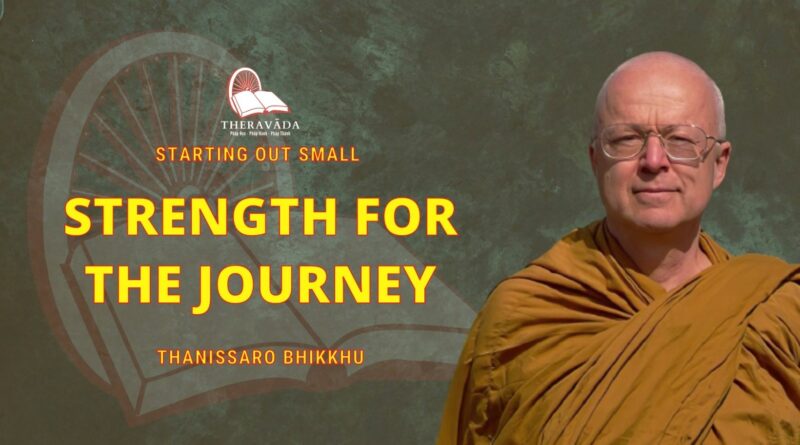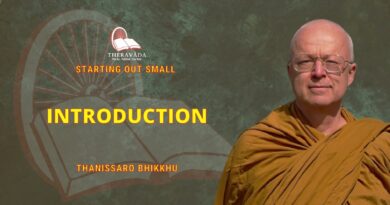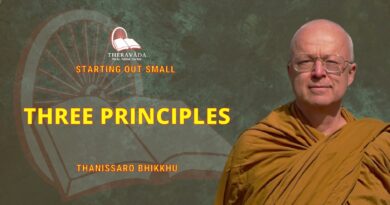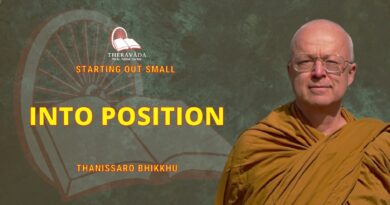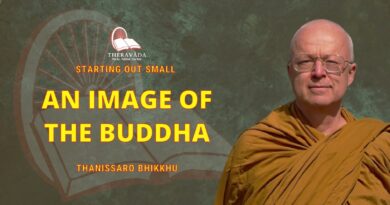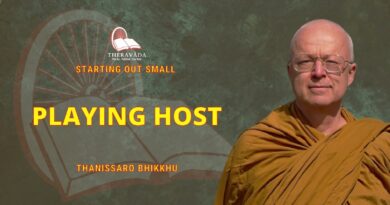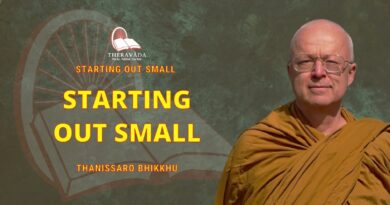STARTING OUT SMALL – 10. STRENGTH FOR THE JOURNEY
When you sit in concentration, you have to keep being observant to see whether the mind is established in all the component factors of meditation. Your practice of concentration has to be composed of three component factors for it to count as correct in line with the principles of meditation that will give rise to the full results that we all want. The component factors of meditation are:
- The right object.This refers to the object on which the mind settles — or in other words, the breath. We have to focus our awareness on the breath and not let it stray out in other directions. This is the “thana” or foundation of our kammatthana.
- The right intention.Once we’ve focused our awareness on the in-and-out breath, we have to keep our mindfulness fixed solely on the breath by thinking bud- in with the in-breath, and dho out with the out. We have to keep doing this until the mind is still and in place. Then we can drop the meditation word. Once the mind is still and doesn’t go wandering off in other places, mindfulness will stay snug with the breath without slipping away or growing absent minded. This is the intention, the kamma of our kammatthana.
- The right quality.This refers to the skill with which we can improve, adjust, and spread the breath so that it becomes comfortable. For example, if short breathing is uncomfortable, change it so that it’s a little longer. If long breathing is uncomfortable, change it so that it’s a bit shorter. Observe long breathing, short breathing, fast or slow breathing, and then keep on breathing in whichever way is most comfortable. If any problem or discomfort arises, make further changes. But don’t tense up the breath or try to hold it. Let the body breathe in and out with a sense of ease. The breath will then feel wide open, agile, and spacious. It won’t get bottled up in any one spot, won’t feel heavy or confined. When this is the case, a sense of fullness and refreshment, a cool sense of ease will arise in the mind. As for the body, it’ll feel at ease as well. This is the essence of what is good, the skillfulness that we all desire.
When we can train the mind to stay firmly in these three factors of meditation, it’ll become tame and obedient, and no longer stubborn — because once our mind becomes skillful and intelligent, it’ll gain a sense of what’s good for us, what’s not, what are the affairs of other people, what are our own affairs. When this happens, there won’t be a lot of confusion. It’s the same as when we’ve trained an ox. We can put it to good work and won’t have to waste a lot of rope to keep it tied down. That’s when we can be at our ease. Even if we let it wander off on its own, it won’t get lost. When it goes away, it’ll come back to its pen on its own, for it knows which pen belongs to its owner, which pens belong to other people, which person is its owner and which people are not, which plants are the grasses it can eat, which plants are the rice plants it shouldn’t. This way it won’t invade the fields of other people, trampling their crops and eating their rice, which would give rise to all sorts of controversies and bad feelings. That way, we can live in peace.
It’s the same with the mind. Once it’s trained, it’ll become tame. It won’t go traipsing off after external thoughts and preoccupations. Normally, the mind doesn’t like to stay with the body in the present. Sometimes it goes flowing out the eyes, sometimes out the ears, sometimes out the nose, the tongue, and the body, so that it splits into five different currents, just like a river that splits into five channels instead of staying in one: the force of the current gets weakened. And in addition to leaking out the five sense doors after sights, sounds, smells, tastes, and tactile sensations, the mind also goes flowing out after thoughts of the past and thoughts of the future without ever staying firmly in the present. This is why it knows no peace, because it doesn’t get any time to rest. As a result, its strength begins to fail, and when the strength of the mind grows weaker, so does the strength of the body. When this is the case, we can’t bring any of our projects to completion, either in the area of the world or of the Dhamma.
When this happens, we’re like a sick person who’s a burden on his doctors and nurses. The doctors have to keep making visits to check up on his symptoms. The nurses have to feed him, give him medicine, and take him to the bathroom. When he tries to sit up, he needs someone to support him. The people looking after him have to go without sleep both by day and by night, and can never leave him alone. As for the people financially responsible, they have to run around trying to find money to pay the medical bills. The whole family is worried and concerned, and the sick person himself can find no comfort. He can’t go anywhere, can’t do anything, can’t eat solid food, can’t get any sleep: everything becomes a problem.
In the same way, when our minds aren’t quiet and still, and instead keep flowing out after concepts and preoccupations, we’re like sick people. We don’t have the strength to bring our work to completion. This is because the untrained mind goes wandering off as it likes and is very stubborn. You can’t tell it to do anything at all. If you tell it to lie down, it’ll sit down. If you tell it to sit down, it’ll get up and walk. If you tell it to walk, it’ll start running. If you tell it to run, it’ll stop. You can’t really control it at all. When this is the case, all sorts of unskillful qualities — ignorance and defilements like greed, anger, and delusion, or the five Hindrances — will come flowing into the mind, overcoming it and possessing it in the same way that people get possessed by spirits. When this is the case, we’re in all sorts of trouble and turmoil — all because the mind doesn’t have the strength it needs to withstand ignorance or to drive it out of the heart.
The Buddha saw that this is the way things are for people by and large, causing them to suffer, which is why he taught us to gather up the strength of body and strength of mind we need to fight off these various forms of suffering. In other words, he taught us to practice concentration so as to make the strength of our mind firm and solid. Practicing concentration means training the mind to be quiet and still. As the mind stays quiet and still for longer and longer periods of time, it’ll become clear. When it’s clear, the light of discernment will arise within it. This discernment is the strength that will enable the mind to contend with all sorts of events, both good and bad, for it’ll have the intelligence enabling it to wise up to all the preoccupations coming in by way of the eyes, ears, nose, tongue, body, and intellect. It will be able to identify perceptions of past, present, and future. It will be acquainted with the properties, aggregates, and sense media, knowing what’s good, what isn’t, what’s worth thinking about, what’s not, what’s untrue, what’s true. When it knows this, it’ll become dispassionate, disenchanted, and will let go of all thoughts and concepts, let go of its attachments to the body, let go of its attachments to things outside, all of which arise from the process of fabrication and have no real enduring essence.
When the mind can let go of all thoughts and preoccupations, it’ll become light and agile, like a person who has put down all the burdens she’s been carrying on her shoulders and in her hands. She can walk, run, and jump with agility. She can sit down or lie down with ease. Wherever she goes, she’s comfortable. When the mind has experienced a sense of comfort, it’ll become happy and full. It won’t feel hungry. When it’s full and happy, it can rest. Once it’s rested, it’ll have strength. Whatever tasks it undertakes, in terms of the world or the Dhamma, will succeed. If the mind lacks a sense of fullness, though, it’ll be hungry. When it’s hungry, it’s in a lousy mood: irritable and upset. When this is the case, it’s like a sick person who doesn’t have the strength to complete any task with ease.
As for people who have practiced concentration to the point where their minds are quiet and still, they’re no longer hungry, for they have a sense of fullness within them. This gives them five kinds of strength — conviction, persistence, mindfulness, concentration, and discernment — which will enable them to advance to even higher levels of goodness. When the mind is still, it develops mental serenity. When the body is still, it develops physical serenity as well: the various properties within it are peaceful and harmonious, and don’t quarrel with one another. The whole body is then bathed in the purity that comes flowing out the currents of the mind through the properties of earth, water, fire, and wind, caring for them and protecting them. When things are protected and cared for, they don’t run down. In this way the properties of the body reach a state of harmony, giving them the strength they need to withstand feelings of pain and weariness. As for the mind, it’ll develop greater and greater strength, enabling it to withstand all sorts of mental torments. It’ll keep getting more and more powerful, like the gunpowder used to make rockets and fireworks. When it’s lit, it explodes and shoots all the way up to the sky.
When we practice concentration, it’s as if we were gathering provisions for a trip. The provisions here are the skillful qualities we develop in the mind. The more provisions we have, the more comfortably we can travel and the further we can go. We can go to the human world, the deva worlds, the brahma worlds, or all the way to nibbana. When we have a lot of provisions, our traveling is easy, for we can afford to go by car or by boat. We can stay in comfortable places and have plenty of food to eat. The trip won’t tire us, and we can go far and fast. As for people with meager provisions, they can’t afford the carfare, so they have to go barefoot, walking on gravel and stepping on thorns, exposed to the sun and rain. They can’t stay in comfortable places; they’re lacking in food; their progress is tiring and slow. By the time they reach their destination they’re ready to give up, for they’re all out of strength. But whether we travel quickly or slowly, we’re all headed to the same destination. For example, suppose we’re all going to Bangkok. Those who go by foot will get there in three months; those who go by car, in three days; while those who get on a plane will arrive in three minutes.
For this reason, you shouldn’t get discouraged in your efforts to do what’s good. Develop as much strength as you can, so that you’ll have the provisions and vehicles you’ll need to help speed you along to your goal. Once you’ve arrived, you’ll experience nothing but happiness and ease. When you practice the Dhamma, even if you don’t reach the paths, their fruitions, or nibbana in this lifetime, at the very least you’re developing the conditions that will help you along the way in the future.
When we meditate, it’s as if we were driving a car on a trip. If you have a sense of how to adjust and improve your breath, it’s like driving along a smooth, paved road. The car won’t run into any obstacles, and even a long trip will seem short. As for people who aren’t centered in concentration, whose minds are slipping and slithering around with no sense of how to improve their breathing, they’re driving their car along a bumpy, unpaved road full of potholes. In some spots the bridges have collapsed. In others the road is washed out. What this means is that their mindfulness lapses and they let their minds fall into thoughts of the past and future. They don’t stay put in the present. If they don’t know how to repair their road, they’ll keep running into dangers and obstacles. Their car will keep getting bogged down. Sometimes they spend weeks and months stuck in one place, and their short trip turns into a long one. Sometimes they go back to the beginning point and start all over again. Running back and forth like this, around and around in circles, they’ll never be able to get to the goal.
So I ask that you all remember this discussion of the Dhamma and take it to heart. Try using it to make adjustments in your mind and see what happens. If you train the mind correctly in line with the three factors of meditation that I’ve mentioned here, you may well meet with the peace and happiness for which you aim.
Source: Budsas.net

